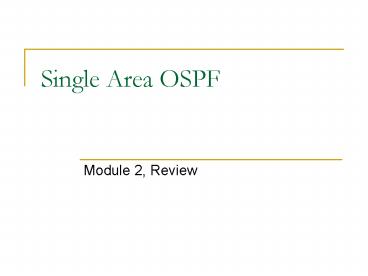Single Area OSPF - PowerPoint PPT Presentation
1 / 17
Title:
Single Area OSPF
Description:
Use the following interface configuration command to set the link cost: Router(config-if)#ip ospf cost number ... are not the same. Interfaces are on different ... – PowerPoint PPT presentation
Number of Views:32
Avg rating:3.0/5.0
Title: Single Area OSPF
1
Single Area OSPF
- Module 2, Review
2
2.1.3 How routing information is maintained
- Link-state routers apply the Dijkstra shortest
path first algorithm against the link-state
database. This builds the SPF tree with the local
router as the root.
3
2.1.4 Link-state routing algorithms
- An LSA exchange is triggered by an event in the
network instead of periodic updates. This speeds
up the convergence process because there is no
need to wait for a series of timers to expire
before the routers can converge.
4
2.1.5 Advantages and disadvantages of link-state
routing
- The following are advantages of link-state
routing protocols - Each router has a complete and synchronized
picture of the network. Therefore, it is very
difficult for routing loops to occur.
5
2.1.5 Advantages and disadvantages of link-state
routing
- The following are some disadvantages of
link-state routing protocols - They require more memory and processor power than
distance vector protocols. This makes it
expensive to use for organizations with small
budgets and legacy hardware. - They require strict hierarchical network design,
so that a network can be broken into smaller
areas to reduce the size of the topology tables. - They require an administrator who understands the
protocols well.
6
2.2.1 OSPF overview
- Multiple areas connect to a distribution area, or
area 0 which is also called the backbone. - The hierarchical design approach allows for
extensive control of routing updates. Area
definition reduces routing overhead, speeds up
convergence, confines network instability to an
area, and improves performance.
7
2.2.3 Comparing OSPF with distance vector
routing protocols
- OSPF selects routes based on cost, which is
related to speed. The higher the bandwidth, the
lower the OSPF cost of the link.
8
2.2.5 OSPF network types
- OSPF interfaces recognize three types of
networks - Broadcast multi-access, such as Ethernet
- Point-to-point networks
- Nonbroadcast multi-access (NBMA), such as Frame
Relay - On point-to-point networks only two nodes exist
and no DR or BDR is elected. Both routers become
fully adjacent with each other.
9
2.2.5 OSPF network types
- In a multi-access network, it is not known in
advance how many routers will be connected. - If every router had to establish full adjacency
with every other router and exchange link-state
information with every neighbor, there would be
too much overhead. - The solution to this overhead is to hold an
election for a designated router (DR). A second
router is elected as a backup designated router
(BDR) to take over the duties of the DR if it
should fail.
10
2.2.6 OSPF Hello protocol
- At Layer 3 of the OSI model, the hello packets
are addressed to the multicast address 224.0.0.5.
This address is all OSPF routers.
11
2.3.1 Configuring OSPF routing process
12
2.3.2 Configuring OSPF loopback address and
router priority
- A router with the highest OSPF priority will be
selected as the DR. A router with the second
highest priority will be the BDR. After the
election process, the DR and BDR retain their
roles even if routers are added to the network
with higher OSPF priority values. - If the network type of an interface is broadcast,
the default OSPF priority is 1. When OSPF
priorities are the same, the OSPF election for DR
is decided on the router ID. The highest router
ID is selected. - The election result can be determined by ensuring
that the ballots, the hello packets, contain a
priority for that router interface. The interface
reporting the highest priority for a router will
ensure that it becomes the DR.
13
2.3.3 Modifying OSPF cost metric
- Use the following interface configuration command
to set the link cost - Router(config-if)ip ospf cost number
- Costs are also associated with externally derived
routing data. In general, the path cost is
calculated using the formula 108/ bandwidth,
where bandwidth is expressed in bps.
14
2.3.4 Configuring OSPF authentication
- Use the following command syntax to configure
OSPF authentication - Router(config-if)ip ospf authentication-keypasswo
rd
15
2.3.6 OSPF, propagating a default route
- A configured default route is used by a router to
generate a gateway of last resort. The static
default route configuration syntax uses the
network 0.0.0.0 address and a subnet mask
0.0.0.0 - Router(config)ip route 0.0.0.0 0.0.0.0
interface next-hop address - This is referred to as the quad-zero route, and
any network address is matched using the
following rule. The network gateway is determined
by ANDing the packet destination with the subnet
mask. - The following configuration statement will
propagate this route to all the routers in a
normal OSPF area - Router(config-router)default-information
originate - All routers in the OSPF area will learn a default
route provided that the interface of the border
router to the default gateway is active.
16
2.3.7 Common OSPF configuration issues
- Failure to establish a neighbor relationship is
caused by any of the following reasons - Hellos are not sent from both neighbors.
- Hello and dead interval timers are not the same.
- Interfaces are on different network types.
- Authentication passwords or keys are different.
17
2.3.8 Verifying the OSPF configuration































